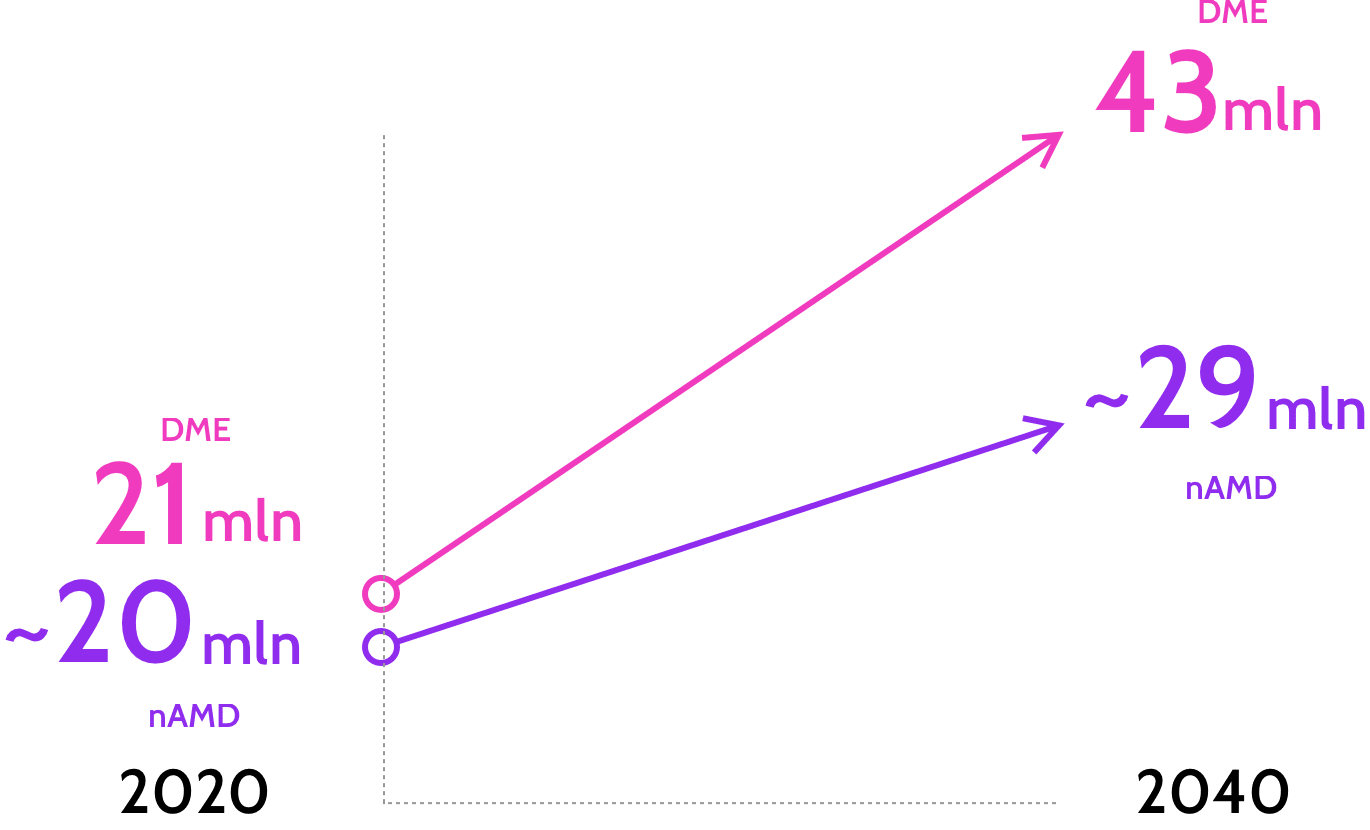
Look
beyond
limits

Look
beyond
limits
The reality of retinal disease
Retinal disease is a significant public health issue that is now affecting more of us than ever before. The number of people living with two of the leading causes of vision loss - Neovascular Age-related Macular Degeneration (nAMD) and Diabetic Macular Edema (DME) - worldwide is set to grow,1–8 further increasing the pressure on health system capacity.
Projected number of people living with retinal disease1-6

These diseases can have a devastating impact upon our work, our health systems, and those we care about most by closing the window to independence.
People may struggle to:9–13
These diseases can have a devastating impact upon our work, our health systems, and those we care about most by closing the window to independence.
People may struggle to:9–13
Current therapy limitations
Anti-VEGF IVT treatments have been shown to improve vision for many people with retinal vascular disease. However, those benefits are difficult to achieve and maintain in the real world without frequent injections.16-19
Frequent IVT injections place a significant burden on peoples’ lives:20–22

22-57% of people with nAMD stop anti-VEGF IVT treatment over 5 years in real-world studies (common reasons include distance to hospital and number of visits)23-25
Vision outcomes deteriorate over time despite injections every 2-3 months:14,19

Real-world studies in DME and nAMD found that average vision gains worsened between 2 and 5 years of anti-VEGF treatment, despite people receiving 4-5 injections annually
Other disease pathways may lead to long-term detrimental effects on vision:26-28

Inhibiting VEGF alone does not address the inflammatory response associated with the progression of nAMD and DME28
Continuous dosing may offer an alternative solution:29

The majority of nAMD patients who received continuous fixed-interval dosing of anti-VEGF experienced stabilisation or even improvement of their vision29
It’s time for a new approach
Treatments with new modes of action and better delivery mechanisms are needed to address the multifactorial nature of retinal disease, to help patients achieve longer‑term vision gains and reduce the burden of treatment.
Step into the future of ophthalmology
Find out more by registering your interest here
References
1. Yau J, Rogers S, Kawasaki R, et al. Global Prevalence and Major Risk Factors of Diabetic Retinopathy. Diabetes Care. 2012;35:556–64.
2. Ogurtsova K, da Rocha Fernandes JD, Huang Y, et al. IDF Diabetes Atlas: Global estimates for the prevalence of diabetes for 2015 and 2040. Elsevier. 2017;128:40-50.
3. Cheloni R, Gandolfi SA, Signorelli C, et al. Global prevalence of diabetic retinopathy: protocol for a systematic review and meta-analysis. BMJ Open. 2019;9:e022188. doi:10.1136/bmjopen-2018-022188.
4. Connolly E, Rhatigan M, O’Halloran AM, et al. Prevalence of age-related macular degeneration associated genetic risk factors and 4-year progression data in the Irish population. Br J Ophthalmol. 2018;102:1691–95.
5. Bright Focus Foundation; Age-Related Macular Degeneration: Facts & Figures, 2019. Available from: www.brightfocus.org/macular/article/age-related-macular-facts-figures [Accessed December 2021].
6. Wong WL, Su X, Li X et al. Global prevalence of age-related macular degeneration and disease burden projection for 2020 and 2040: a systematic review and meta-analysis. The Lancet Global Health. 2014; 2(2): e106-e116.
7. Macon C, Carrier H, Janczewski A, et al. Effect of Automobile Travel Time Between Patients’ Homes and Ophthalmologists’ Offices on Screening for Diabetic Retinopathy. Telemed J E Health. 2018;24(1):11-20.
8. Rose MA, Vukicevic M, Koklanis K, et al. Experiences and perceptions of patients undergoing treatment and quality of life impact of diabetic macular edema: a systematic review. Psychol Health Med. 2019;24(4):383-401.
9. Elshout M, Webers CA, Van Der Reis MI, et al. Tracing the natural course of visual acuity and quality of life in neovascular age-related macular degeneration: A systematic review and quality of life study. BMC Ophthalmol. 2017;17(1):120.
10. Xu K, Gupta V, Bae S, Sharma S. Metamorphopsia and vision-related quality of life among patients with age-related macular degeneration. Can J Ophthalmol. 2018;53(2):168-72.
11. Bian W, Wan J, Smith G, et al. Domains of health-related quality of life in age-related macular degeneration: a qualitative study in the Chinese cultural context. BMJ Open. 2018;8(4):e018756.
12. Prem SM, Khadka J, Gilhotra JS, et al. Exploring the quality of life issues in people with retinal diseases: a qualitative study. J Patient Rep Outcomes. 2017;1(1):15.
13. Dev MK, Paudel N, Joshi ND, et al. Impact of visual impairment on vision-specific quality of life among older adults living in nursing home. Curr Eye Res. 2014;39(3):232-8.
14. Monés J, Singh RP, Bandello F, et al. Undertreatment of Neovascular Age-Related Macular Degeneration after 10 Years of Anti-Vascular Endothelial Growth Factor Therapy in the Real World: The Need for A Change of Mindset. Ophthalmologica. 2020;243(1):1-8.
15. International Federation on Ageing. International Federation on Ageing. The high cost of low vision. 2013. Available from: https://ifa.ngo/wp-content/uploads/2013/02/The-High-Cost-of-Low-Vision-The-Evidence-on-Ageing-and-the-Loss-of-Sight.pdf [Accessed December 2021].
16. Ciulla TA et al. Visual Acuity Outcomes and Anti-Vascular Endothelial Growth Factor Therapy Intensity in Neovascular Age-Related Macular Degeneration Patients: A Real-World Analysis of 49 485 Eyes Ophthalmol Retina 2020;4(1):19-30.
17. Comparison of Age-related Macular Degeneration Treatments Trials (CATT) Research Group. Ophthalmology. 2016;123(8):1751–61.
18. Ciulla TA et al. Visual acuity outcomes and anti-VEGF therapy intensity in diabetic macular oedema: a real-world analysis of 28 658 patient eyes. Br J Ophthalmol 2021;105(2):216-21.
19. Glassman AR et al. Ophthalmology 2020;127(9):1201-10.
20. Holekamp NM et al. Barriers to adherence to age-related macular degeneration and diabetic macular edema management plans: A multi-national qualitative study. Presented at ARVO 2021. May 1-7, 2021.
21. Sivaprasad S and Oyetunde S. Impact of injection therapy on retinal patients with diabetic macular edema or retinal vein occlusion. Clin Ophthalmol. 2016;10:939-46.
22. Spooner KL et al. The burden of neovascular age-related macular degeneration: a patient's perspective. Clin Ophthalmol. 2018;12:2483–91.
23. Boulanger-Scemama E, et al. Ranibizumab for exudative age-related macular degeneration: A five year study of adherence to follow-up in a real-life setting. J Fr Ophtalmol. 2015;38:620–7.
24. Obeid A, et al. Loss to Follow-up Among Patients With Neovascular Age-Related Macular Degeneration Who Received Intravitreal Anti–Vascular Endothelial Growth Factor Injections. JAMA Ophthalmol. 2018;136:1251–9.
25. Gillies MC, et al. Long-Term Outcomes of Treatment of Neovascular Age-Related Macular Degeneration: Data from an Observational Study. Ophthalmology. 2015;122:1837–45.
26. Adamis, Anthony P et al. Building on the success of anti-vascular endothelial growth factor therapy: a vision for the next decade. Eye. 2020;34(11):1966-72.
27. Chakravarthy U, Yang Y, Lotery A, et al. Clinical Evidence Of The Multifactorial Nature Of Diabetic Macular Edema. Retina. 2018;38(2):343-51.
28. Joussen AM, Ricci F, Paris LP, et al. Angiopoietin/tie2 signalling and its role in retinal and choroidal vascular diseases: A review of preclinical data. Eye (Lond) 2021;35:1305–16.
29. Peden MC, Suñer IJ, Hammer ME, Grizzard WS. Long-term outcomes in eyes receiving fixed-interval dosing of anti-vascular endothelial growth factor agents for wet age-related macular degeneration. Ophthalmology. 2015;122(4):803-8.







